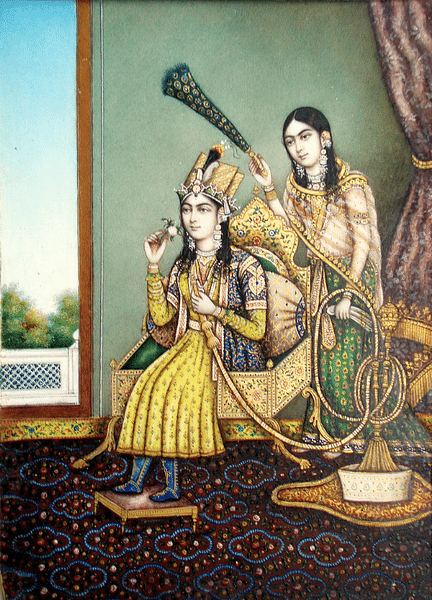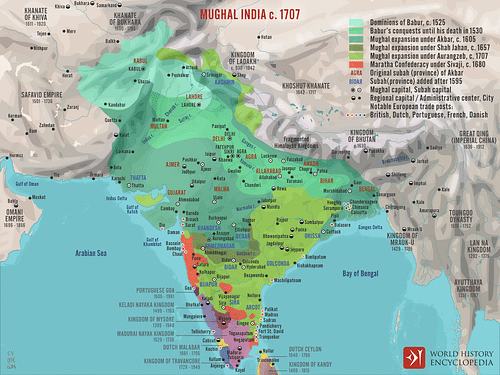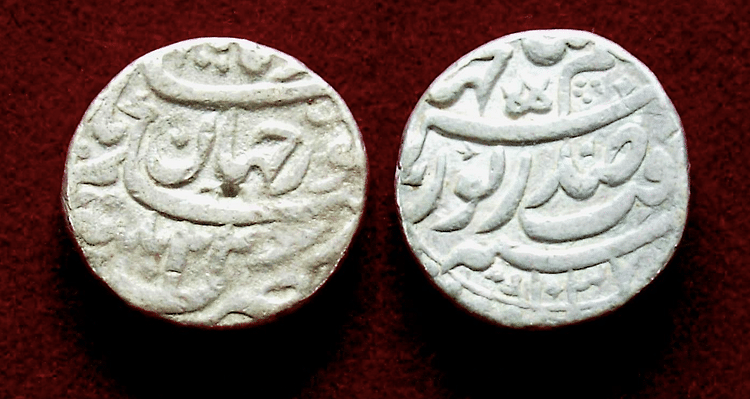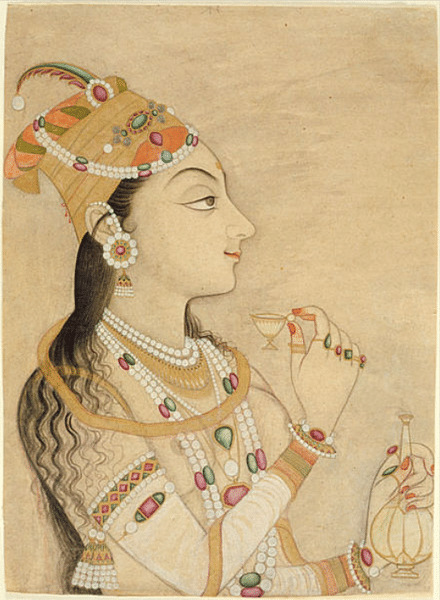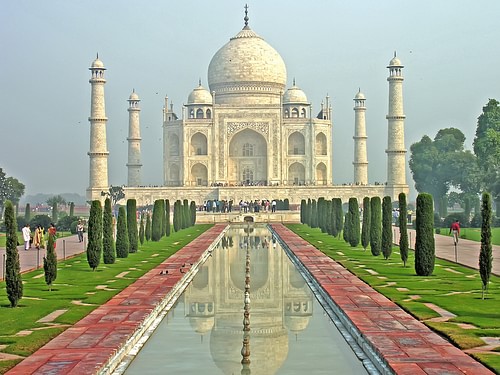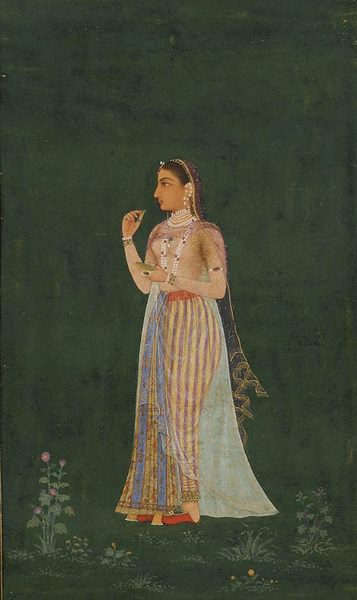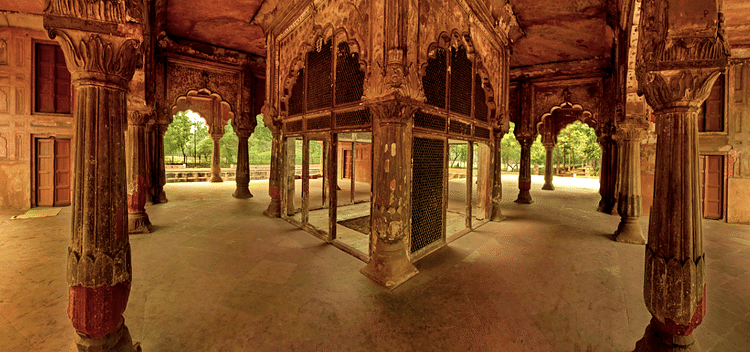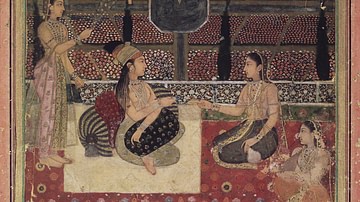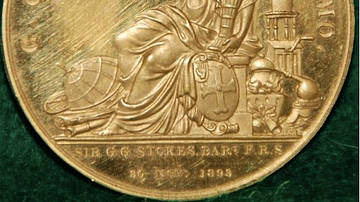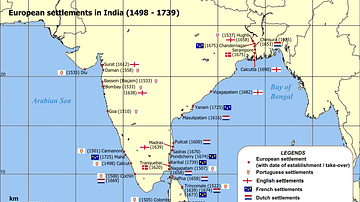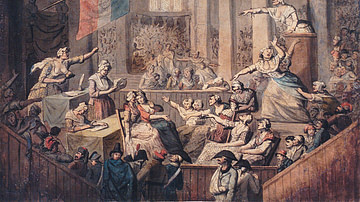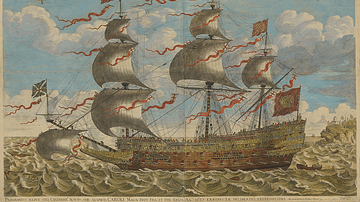It was not only the Mughal emperors that left an indelible mark in the history of the Indian subcontinent but also the queens and princesses. The latter's contributions to art, architecture, literature, cuisine, refinement, and administrative institutions were remarkable. The impact of these women is still being felt in the life of the people of India, Bangladesh, and Pakistan today.
The Mughal Empire
The Mughal dynasty, established by Zahiruddin Mohammad Babur (r. 1526–1530), continued with all its splendour and glory until Aurangzeb (1618-1707). A decline began after the rule of the Great Mughals. The Later Mughals' reign witnessed the Mughal Empire's disintegration, and the last Emperor, Bahadur Shah Zafar (r. 1837-1857), was only a nominal ruler. The victory of Babur against the last ruler of the tottering Lodi dynasty on April 21, 1526, at the first battle of Panipat, changed the course of Indian history.
A composite culture evolved with the amalgamation of old with new. The aristocratic Mughal ladies did not lead a secluded life in the cloistered walls of the harem. They had a definite role in various facets of social and political life. Beginning with Aisan Daulat Begum, maternal granddaughter of Babur, the Mughal ladies such as the author of Humayun Nama Gulbadan Banu Begum (daughter of Babur and sister of Humayun), Maham Anaga (foster mother of Akbar ), Mah Chuchak Begum (stepmother of Akbar), Nur Jahan (queen of Jahangir), Mumtaz Mahal (queen of Shah Jahan ), Jahanara Begum as well as Roshanara Begum (daughter of Shah Jahan) influenced politics, culture, and society of the period.
When the heated debate is going on about wearing hijab by Muslim ladies in India encompassing ideological and religious polemics, it is interesting to go back to the past surrounding the status of Muslim women in Mughal India. The present is intertwined with the past, both supplementing each other. A section of society in contemporary India is imposing a strict dress code for Muslim women. Juxtaposing it with the status of Muslim women about 400 years earlier would give the readers a contrasting view. It would be worthwhile to know the activities of the Mughal queens and princesses. Were they independent in their thought process? What was their contribution to the then society? Did they share power in the Mughal administration? Was there gender empowerment in medieval India?
Women's Status
The Mughal royal women played a significant role in consolidating and holding the stature of the Mughal Empire in South Asia. Their contributions in political, economic, cultural, and religious spheres advanced the Empire's strength, besides the prosperity of the rulers. While the famous men of the Mughal royal family get attention and appreciation, the lives, activities, achievements, and contributions of the royal Mughal ladies have rarely received due attention from scholars. The role of these royal women in politics was noteworthy as these women were actively engaged in both harem and court politics. Their ideas hugely impacted the rulers, and many even ruled the Empire behind the curtains on behalf of the rulers.
Besides these royal women, the space of the zenana (the women's quarters of a household) has also been overlooked by researchers. In its place, the harem has been depicted as a place of only sensuous indulgence, where thousands of nubile womenfolk were held captive and led cloistered lives as sex objects in an atmosphere of jealousy and frustration. Conspiracies about succession to the throne were rampant. However, the truth is somewhat more complex and surprisingly something else.
The women's quarter was a multicultural space, not only for the rulers' consorts. It was meant for relatives seeking asylum from other kingdoms, widows of important generals, Portuguese and English servants, women soldiers acting as guards, unmarried relatives, respected grandmas and aunts, Rajput princesses and children, attendants, and tradeswomen of all types. The highest-ranking women of the Mughal era enjoyed a highly sophisticated life of luxury, aesthetics, and specific advisory power.
Some noble women in the imperial household are chronicled as powerful as their spouses, occasionally demonstrating more decisive roles in government and acting as patrons of the arts, science, and literature. These royal ladies often understood their power and worked as formidable lobby groups.
The contemporary Persian accounts mainly described the court histories concerned with the several eventful activities in the lives of the emperors. Though these records mention the royal women in specific contexts as a part of the more significant account, distinct and detailed descriptions of their lives are absent. While the memoirs of Babar and Jahangir mention the royal women related to them here, details about the ladies still need to be found.
Below are short biographies of four key Mughal royal women. They are:
- Nur Jahan (c. 1577-1645)
- Mumtaz Mahal (1593-1631)
- Jahanara Begum (1614-81)
- Roshanara Begum (1617-71)
Nur Jahan
The most influential woman at the time of the Mughal Emperor Jahangir (r. 1605-1627), Mehrunnissa was born at Kandahar to Persian immigrant Mirza Ghiyas Baig (Itmatuddaulah) and Asmat Begum. In 1607, she worked in the harem after the death of her husband, Quli Khan. Jahangir met her for the first time in 1611 and was infatuated. Named Nur Mahal or 'Light of the Palace' after marriage with the emperor, she was bestowed with the title Nur Jahan ('Light of the World') five years later.
Queen Nur Jahan, an intelligent and elegant lady, became very active in court politics, wielding power through her clique, known as the Nur Jahan junta. Her name was inscribed on the coinage, and Nur Jahan sometimes gave audiences in her palace. An ace shooter and hunter of wild animals, Nur Jahan delved into political intrigues. She was instrumental in making her father and brother Asaf Khan high officers in the court. Ladli Begum, her daughter from her first marriage, was married to the son of Jahangir, Shahryar, who became Nur Jahan's candidate for the Mughal throne. Prince Khurram, the future Shah Jahan (r.1 627-1658), rebelled against Jahangir, which was suppressed.
Modern historians have questioned the credibility of Nur Jahan's junta. Jahangir was active and did not neglect the affairs of the state. Much of the bias against the queen was the anti-feminist posture of contemporary historians. Nur Jahana's last days were spent supervising her father's mausoleum in Agra. A cultured lady, she was a trendsetter in clothing, cosmetics, and perfumes of the Mughal zenana.
Mumtaz Mahal
The wife of Emperor Shah Jahan (r. 1628-1658), Mumtaz Mahal (aka Mumtaz-i-Mahal), has been immortalized because of her deep love for her husband and the source of inspiration behind the Taj Mahal. Known earlier as Arjumand Banu Begum, she was born in April 1593 in Agra to a highly connected and well-placed Persian family. Her father, Asaf Khan (d. 1641), was the Mir Bakshi (War Minister), and her grandfather Itimaduddaula was the Wazir (Revenue Minister) of the Mughal administration. Moreover, Asaf Khan's sister was the famous Nur Jahan (1577-1645). A lady of exceptional beauty and grace, many legends had been woven around Arjumand. Prince Khurram, the future Shah Jahan, was charmed by her in the Meena Bazar (a type of market for the ladies of the Mughals) in 1607. Arjumand was operating a shop of glass beads and silk. Love at first sight blossomed, and both were married after five years, befitting a royal wedding. She received maximum love, care, affection, and passion among the wives of Shah Jahan, who adorned her with the title Mumtaz Mahal Begum ('Beloved Ornament of the Palace'). The couple shared an intimate bond lasting for a lifetime.
Mumtaz Mahal was unlike some other queens in the medieval and early-modern era, simply living a life of luxury or indulging in court intrigues. She was many times a companion to Shah Jahan on military campaigns. Mumtaz was a pillar of support to the emperor in times of tribulation through her care, comfort, and counsel. She was the favorite wife while queens like Akbarabadi Mahal (d. 1677), Kandahari Mahal (b. 1594), Hasina Begum Sahiba (m. 1617), Manbhavathi Sahiba (m. 1626), and others all had a perfunctory relationship with Shah Jahan. He trusted Mumtaz Mahal so much that the Muhr Uzah (imperial seal) was given to her. The couple had seven surviving children out of fourteen, many of whom had left their mark on Mughal history. Jahanara Begum (1614-1681), a gifted and cultured lady, was the Padishah Begum, Empress of Princesses, who tended the imprisoned Shah Jahan. The eldest son, Dara Shikoh (1615-1659), was the Emperor's favourite and a reputed scholar. Mumtaz did not survive the bloody War of Succession among her sons: Dara (1615-1659), Shuja (1616-1660), Aurangzeb (1618-1707), and Murad (1624-1661). Mumtaz had, at least, taken care of the education of her children. Her secretary Sati-un Nissa tutored the royal siblings. A pious and kind lady, Mumtaz assisted needy and destitute women.
While accompanying the emperor on a military campaign, the pregnant Mumtaz died on June 17, 1631, after delivering the fourteenth child, Gauhara Begum (1631-1706). The story goes that she made her last wish of erecting a monument as a symbol of true love. A remorseful Shah Jahan kept his promise and ordered the construction of the magnificent Taj Mahal. After six months, the Queen's body was exhumed from Zainabadi garden, Burhanpur, where it was given a temporary burial. The Taj became her mausoleum finally. The tomb, a symbol of undying love, is one of the "Seven Wonders" of the modern world and a major tourist destination.
Jahanara Begum
Jahanara Begum was the second and the eldest living child of Emperor Shah Jahan and Mumtaz Mahal. After Mumtaz’s unfortunate death in 1631, the 17-year-old Jahanara was assigned to the royal seal and received the title of Padshah Begum (First lady) of the Mughal Empire. However, her father had three other wives. Being Shah Jahan’s favourite daughter, she wielded key political influence during her father’s rule and was often known as “the most powerful woman in the empire” during that time. She strongly supported her brother, Dara Shikoh as her father’s successor. She sided with the heir-apparent Dara during the war of succession after Shah Jahan’s illness in 1657. She finally joined her father in Agra Fort, where her father had been placed under house arrest by Aurangzeb. Being a dedicated daughter, she cared for Shah Jahan until his death in 1666. Later, she reconciled with Aurangzeb, who conferred the title ‘Empress of Princesses’ and replaced her younger sister, Roshanara Begum, as the First Lady. She was re-engaged in politics, was influential in several crucial matters, and had certain special privileges which other royal women could not enjoy. Jahanara died a spinster during Aurangzeb’s reign.
Roshanara Begum
The third daughter of Emperor Shah Jahan and his wife, Mumtaz Mahal, Roshanara Begum, was a bright princess and a talented poet. She supported her younger brother, Aurangzeb in the war of succession after Shah Jahan's illness in 1657. Roshanara had sibling rivalry with Jahanara, resenting the latter's influence with Shah Jahan. When Aurangzeb became the emperor in 1658, she was awarded the title of Padshah Begum and became the 'First Lady of the Mughal Empire.'
A captivating but overlooked area is now receiving due attention. A fresh look at royal Mughal ladies with their social and cultural engagement with the outside world has been highlighted. These regal women were not in historical focus for a considerable time, but recent research has positioned them in the mainstream study of Mughal and medieval South Asian history. Their role in political and financial decisions has now been acknowledged.
